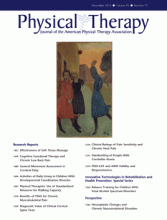Abstract
Background Correlations between clinical and quantitative measures of pain sensitivity are poor, making it difficult for clinicians to detect people with pain sensitivity. Clinical detection of pain sensitivity is important because these people have a different prognosis and may require different treatment.
Objective The purpose of this study was to investigate the relationship between clinical and quantitative measures of pain sensitivity across individuals with and without neck pain.
Methods This cross-sectional study included 40 participants with chronic neck pain and 40 age- and sex-matched controls. Participants underwent quantitative sensory testing of cold pain thresholds (CPTs) and pressure pain thresholds (PPTs). Clinical tests for pain sensitivity were the ice pain test and the pressure pain test. All tests were undertaken at standardized local (neck and upper trapezius muscles) and remote (wrist and tibialis anterior muscles) sites. Median and interquartile range (IQR) were calculated for neck pain and control groups, and parametric and nonparametric tests were used to compare groups. Correlation coefficients were calculated between quantitative and clinical measures.
Results There were significant differences for clinical and quantitative measures of cold and pressure sensitivity between the neck pain and control groups (eg, CPT neck pain group: median=22.31°C, IQR=18.58°C; control group: median=5.0°C, IQR=0.74°C). Moderate-to-good correlations were found between the clinical ice pain test and CPT at all sites (.46 to .68) except at the wrist (.29 to .40). Fair correlations were found for the clinical pressure pain test and PPT (−.26 to −.45). Psychological variables contributing to quantitative measures of pain sensitivity included catastrophization, sleep quality, and female sex.
Limitations Clinical pressure pain tests were not quantitatively standardized in this study.
Conclusions The ice pain test may be useful as a clinical correlate of CPT at all sites except the wrist, whereas the pressure pain test is less convincing as a clinical correlate of PPT.
Footnotes
Dr Rebbeck, Dr Hübscher, Mr Waller, Dr Moloney, and Dr Beales provided concept/idea/research design. All authors provided writing. Dr Rebbeck, Dr Moloney, Ms Azoory, Mr Waller, Ms Gibbons, and Dr Beales provided data collection and study participants. Dr Moloney and Dr Hübscher provided data analysis. Dr Rebbeck and Dr Beales provided project management and institutional liaisons. Dr Rebbeck provided fund procurement. Dr Rebbeck, Dr Moloney, Mr Waller, and Dr Beales provided facilities/equipment. Dr Rebbeck, Dr Moloney, Ms Azoory, Mr Waller, and Miss Gibbons provided consultation (including review of manuscript before submission). The authors acknowledge the assistance of their honors students across the span of this work: Camilla Montague, Basil Chen, Alexandra Griffin, and Natalie Chui-Cheng-Lam.
Human ethics approval was obtained from the University of Sydney Human Ethics Committee (Protocol No. 14417) and the Curtin University Human Research Ethics Committee (Protocol No. PT0205).
Dr Rebbeck and Dr Beales are supported by a National Health and Medical Research Council Research Fellowship. Dr Hübscher was supported by a postdoctoral fellowship from the German Academic Exchange Service (DAAD).
- Received August 21, 2014.
- Accepted May 21, 2015.












